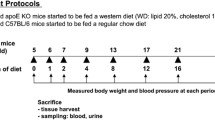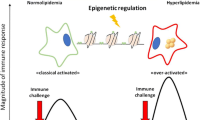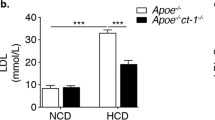Abstract
The effect of hypercholesterolemia induced immune response and inflammation on progression of atherosclerosis in ApoB tm25gy LDLr tm1Her mice, expressing only ApoB100 and deficient in the low density lipoprotein (LDL) receptor, thus closely resembling human cholesterol transport is not well defined. Atherosclerosis was induced by a high cholesterol diet and its progression was studied at 8, 14 and 20 weeks. Antibody response was determined by ELISA. Lymphocytes in spleen and aortic expression of inflammatory markers were studied by flow cytometry, and immunohistochemistry respectively. A rapid increase in plasma LDL levels in the first 8 weeks was followed by the exponential development of atherosclerosis between 8 and 14 weeks. Progression of the disease was accompanied by an accumulation of macrophages and increased expression of IL17 and IFN-γ in the aorta. Hypercholesterolemia resulted in increased immune response to modified lipids and aortic inflammation, with an expansion of Th17 cells in the spleen. Progression of atherosclerosis showed a positive correlation (r = 0.84, P < 0.001) with Th17 cells and a negative correlation with Treg cells (r = 0.83, P < 0.001). IgM antibodies to Ox-LDL and Th17 cells in spleen showed greatest association with disease development. Our results suggest that anti Ox-LDL IgM antibodies, Th17 cells could be developed as a potential marker to study disease progression and to study the effect of therapeutic regulation of inflammation.





Similar content being viewed by others
Abbreviations
- Apo B:
-
Apolipoprotein B
- Apo E:
-
Apolipoprotein E
- Con A:
-
Concanavalin A
- EVG:
-
Elastica van Gieson
- GAPDH:
-
Glyceraldehyde-3 phosphate dehydrogenase
- HDL:
-
High-density lipoprotein
- HFD:
-
High fat diet
- HBSS:
-
Hanks' balanced salt solution
- IL-17:
-
Interleukin-17
- IL-10:
-
Interleukin-10
- IFN-γ:
-
Interferon-γ
- LDL:
-
Low-density lipoprotein
- LDL-R:
-
Low-density lipoprotein receptor
- NBF:
-
Neutral buffered phenol
- Ox-LDL:
-
Oxidized low-density lipoprotein
- ORO:
-
Oil red O
- PMA:
-
Phorbol myristate acetate
- RT-PCR:
-
Real-time polymerase chain reaction
- RPMI:
-
Rosewell Park Memorial Institute
- TC:
-
Total cholesterol
- Th1:
-
T-helper 1
- TGF-β:
-
Transforming growth factor
- TNF-α:
-
Tumor necrosis factor α
References
Hansson GK (2005) Inflammation, atherosclerosis, and coronary artery disease. N Engl J Med 352:1685–1695
Hansson GK (2009) Atherosclerosis–an immune disease: The Anitschkov Lecture 2007. Atherosclerosis 202:2–10
Daugherty A, Rateri DL (2005) Development of experimental designs for atherosclerosis studies in mice. Methods 36:129–138
Daugherty A (2002) Mouse models of atherosclerosis. Am J Med Sci 323:3–10
Getz GS, Reardon CA (2012) Animal models of atherosclerosis. Arterioscler Thromb Vasc Biol 32:1104–1115
Mukhopadhyay R (2013) Mouse models of atherosclerosis: explaining critical roles of lipid metabolism and inflammation. J Appl Genet 54:185–192
Ishibashi S, Brown MS, Goldstein JL, Gerard RD, Hammer RE, Herz J (1993) Hypercholesterolemia in low density lipoprotein receptor knockout mice and its reversal by adenovirus-mediated gene delivery. J Clin Invest 92:883–893
Zhang SH, Reddick RL, Piedrahita JA, Maeda N (1992) Spontaneous hypercholesterolemia and arterial lesions in mice lacking apolipoprotein E. Science 258:468–471
Nakashima Y, Plump AS, Raines EW, Breslow JL, Ross R (1994) ApoE-deficient mice develop lesions of all phases of atherosclerosis throughout the arterial tree. Arterioscler Thromb 14:133–140
Linton MF, Farese RV Jr, Chiesa G, Grass DS, Chin P, Hammer RE, Hobbs HH, Young SG (1993) Transgenic mice expressing high plasma concentrations of human apolipoprotein B100 and lipoprotein(a). J Clin Invest 92:3029–3037
Callow MJ, Stoltzfus LJ, Lawn RM, Rubin EM (1994) Expression of human apolipoprotein B and assembly of lipoprotein(a) in transgenic mice. Proc Natl Acad Sci USA 91:2130–2134
Soutar AK, Naoumova RP (2007) Mechanisms of disease: genetic causes of familial hypercholesterolemia. Nat Clin Pract Cardiovasc Med 4:214–225
Powell-Braxton L, Veniant M, Latvala RD, Hirano KI, Won WB, Ross J, Dybdal N, Zlot CH, Young SG, Davidson NO (1998) A mouse model of human familial hypercholesterolemia: markedly elevated low density lipoprotein cholesterol levels and severe atherosclerosis on a low-fat chow diet. Nat Med 4:934–938
Veniant MM, Pierotti V, Newland D, Cham CM, Sanan DA, Walzem RL, Young SG (1997) Susceptibility to atherosclerosis in mice expressing exclusively apolipoprotein B48 or apolipoprotein B100. J Clin Invest 100:180–188
Ma Y, Wang W, Zhang J, Lu Y, Wu W, Yan H, Wang Y (2012) Hyperlipidemia and atherosclerotic lesion development in Ldlr-deficient mice on a long-term high-fat diet. PLoS One 7:e35835
Reddick RL, Zhang SH, Maeda N (1994) Atherosclerosis in mice lacking apo E. Evaluation of lesional development and progression. Arterioscler Thromb 14:141–147
Martens GW, Vallerskog T, Kornfeld H (2012) Hypercholesterolemic LDL receptor-deficient mice mount a neutrophilic response to tuberculosis despite the timely expression of protective immunity. J Leukoc Biol 91:849–857
Lichtman AH, Binder CJ, Tsimikas S, Witztum JL (2013) Adaptive immunity in atherogenesis: new insights and therapeutic approaches. J Clin Invest 123:27–36
Andersson J, Libby P, Hansson GK (2010) Adaptive immunity and atherosclerosis. Clin Immunol 134:33–46
Hermansson A, Ketelhuth DF, Strodthoff D, Wurm M, Hansson EM, Nicoletti A, Paulsson-Berne G, Hansson GK (2010) Inhibition of T cell response to native low-density lipoprotein reduces atherosclerosis. J Exp Med 207:1081–1093
Lahoute C, Herbin O, Mallat Z, Tedgui A (2011) Adaptive immunity in atherosclerosis: mechanisms and future therapeutic targets. Nat Rev Cardiol 8:348–358
Hansson GK, Hermansson A (2011) The immune system in atherosclerosis. Nat Immunol 12:204–212
Mallat Z, Gojova A, Brun V, Esposito B, Fournier N, Cottrez F, Tedgui A, Groux H (2003) Induction of a regulatory T cell type 1 response reduces the development of atherosclerosis in apolipoprotein E-knockout mice. Circulation 108:1232–1237
Steven Leary WU, Raymond A, Cartner S, Corey D, Grandin T, Greenacre C, McCrackin MA, Meyer R, Miller D, Shearer J,Yanong R, AVMA Guidelines for the Euthanasia of Animals. https://www.avma.org/issues/animal_welfare/euthanasia.pdf
Daugherty A, Whitman SC (2003) Quantification of atherosclerosis in mice. Methods Mol Biol 209:293–309
Feng B, Zhang D, Kuriakose G, Devlin CM, Kockx M, Tabas I (2003) Niemann-Pick C heterozygosity confers resistance to lesional necrosis and macrophage apoptosis in murine atherosclerosis. Proc Natl Acad Sci 100:10423–10428
Mundkur L, Mukhopadhyay R, Samson S, Varma M, Kale D, Chen D, Shivaprasad S, Sivanandan H, Soman V, Lu X, Kakkar VV (2013) Mucosal Tolerance to a Combination of ApoB and HSP60 Peptides Controls Plaque Progression and Stabilizes Vulnerable Plaque in Apob(tm2Sgy)Ldlr(tm1Her)/J Mice. PLoS One 8:e58364
Lopes-Virella MF, Koskinen S, Mironova M, Horne D, Klein R, Chassereau C, Enockson C, Virella G (2000) The preparation of copper-oxidized LDL for the measurement of oxidized LDL antibodies by EIA. Atherosclerosis 152:107–115
Dimayuga PC, Zhao X, Yano J, Chyu KY (2006) Changes in immune responses to oxidized LDL epitopes during aging in hypercholesterolemic apoE(−/−) mice. Am J Physiol Regul Integr Comp Physiol 291:R1644–R1650
Lei L, Li H, Yan F, Xiao Y (2013) Hyperlipidemia Impaired Innate Immune Response to Periodontal Pathogen Porphyromonas gingivalis in Apolipoprotein E Knockout Mice. PLoS One 8:e71849
Martens GW, Arikan MC, Lee J, Ren F, Vallerskog T, Kornfeld H (2008) Hypercholesterolemia impairs immunity to tuberculosis. Infect Immun 76:3464–3472
Robertson AK, Zhou X, Strandvik B, Hansson GK (2004) Severe hypercholesterolaemia leads to strong Th2 responses to an exogenous antigen. Scand J Immunol 59:285–293
Zhou X, Johnston TP, Johansson D, Parini P, Funa K, Svensson J, Hansson GK (2009) Hypercholesterolemia leads to elevated TGF-beta1 activity and T helper 3-dependent autoimmune responses in atherosclerotic mice. Atherosclerosis 204:381–387
Zhou X, Paulsson G, Stemme S, Hansson GK (1998) Hypercholesterolemia is associated with a T helper (Th)1/Th2 switch of the autoimmune response in atherosclerotic apo E-knockout mice. J Clin Invest 101:1717–1725
Hansson GK (2001) Immune mechanisms in atherosclerosis. Arterioscler Thromb Vasc Biol 21:1876–1890
Steinberg D, Parthasarathy S, Carew TE, Khoo JC, Witztum JL (1989) Beyond cholesterol. Modifications of low-density lipoprotein that increase its atherogenicity. N Engl J Med 320:915–924
Binder CJ, Chang MK, Shaw PX, Miller YI, Hartvigsen K, Dewan A, Witztum JL (2002) Innate and acquired immunity in atherogenesis. Nat Med 8:1218–1226
Hansson GK (2002) Vaccination against atherosclerosis: science or fiction? Circulation 106:1599–1601
Stemme S, Faber B, Holm J, Wiklund O, Witztum JL, Hansson GK (1995) T lymphocytes from human atherosclerotic plaques recognize oxidized low density lipoprotein. Proc Natl Acad Sci USA 92:3893–3897
Gao Q, Jiang Y, Ma T, Zhu F, Gao F, Zhang P, Guo C, Wang Q, Wang X, Ma C, Zhang Y, Chen W, Zhang L (2010) A critical function of Th17 proinflammatory cells in the development of atherosclerotic plaque in mice. J Immunol 185:5820–5827
Koga M, Kai H, Yasukawa H, Yamamoto T, Kawai Y, Kato S, Kusaba K, Kai M, Egashira K, Kataoka Y, Imaizumi T (2007) Inhibition of progression and stabilization of plaques by postnatal interferon-gamma function blocking in ApoE-knockout mice. Circ Res 101:348–356
Methe H, Brunner S, Wiegand D, Nabauer M, Koglin J, Edelman ER (2005) Enhanced T-helper-1 lymphocyte activation patterns in acute coronary syndromes. J Am Coll Cardiol 45:1939–1945
Eid RE, Rao DA, Zhou J, Lo SF, Ranjbaran H, Gallo A, Sokol SI, Pfau S, Pober JS, Tellides G (2009) Interleukin-17 and interferon-gamma are produced concomitantly by human coronary artery-infiltrating T cells and act synergistically on vascular smooth muscle cells. Circulation 119:1424–1432
Cheng X, Yu X, Ding YJ, Fu QQ, Xie JJ, Tang TT, Yao R, Chen Y, Liao YH (2008) The Th17/Treg imbalance in patients with acute coronary syndrome. Clin Immunol 127:89–97
Gao Q, Jiang Y, Ma T, Zhu F, Gao F, Zhang P, Guo C, Wang Q, Wang X, Ma C, Zhang Y, Chen W, Zhang L (2010) A critical function of Th17 proinflammatory cells in the development of atherosclerotic plaque in mice. J Immunol 185:5820–5827
Taleb S, Tedgui A, Mallat Z (2015) IL-17 and Th17 cells in atherosclerosis: subtle and contextual roles. Arterioscler Thromb Vasc Biol 35:258–264
Taleb S, Romain M, Ramkhelawon B, Uyttenhove C, Pasterkamp G, Herbin O, Esposito B, Perez N, Yasukawa H, Van Snick J, Yoshimura A, Tedgui A, Mallat Z (2009) Loss of SOCS3 expression in T cells reveals a regulatory role for interleukin-17 in atherosclerosis. J Exp Med 206:2067–2077
Erbel C, Chen L, Bea F, Wangler S, Celik S, Lasitschka F, Wang Y, Bockler D, Katus HA, Dengler TJ (2009) Inhibition of IL-17A attenuates atherosclerotic lesion development in apoE-deficient mice. J Immunol 183:8167–8175
van Dijk RA, Duinisveld AJF, Schaapherder AF, Mulder-Stapel A, Hamming JF, Kuiper J, de Boer OJ, van der Wal AC, Kolodgie FD, Virmani R, Lindeman JHN (2015) A Change in Inflammatory Footprint Precedes Plaque Instability: a systematic evaluation of cellular aspects of the adaptive immune response in human atherosclerosis. J Am Heart Assoc 4
Maganto-Garcia E, Tarrio ML, Grabie N, Bu DX, Lichtman AH (2011) Dynamic changes in regulatory T cells are linked to levels of diet-induced hypercholesterolemia. Circulation 124:185–195
Acknowledgments
We gratefully acknowledge the support of the trustees of Thrombosis Research Institute, London and Bangalore and the Tata Social Welfare Trust, India (TSWT/IG/SNB/JP/Sdm). The study was supported by Department of Biotechnology, Ministry of Science and Technology, Government of India (BT/01/CDE/08/07) and Garry Weston foundation UK.
Author information
Authors and Affiliations
Corresponding author
Ethics declarations
Conflict of interest
None.
About this article
Cite this article
Rao, L.N., Ponnusamy, T., Philip, S. et al. Hypercholesterolemia Induced Immune Response and Inflammation on Progression of Atherosclerosis in Apob tm2Sgy Ldlr tm1Her/J Mice. Lipids 50, 785–797 (2015). https://doi.org/10.1007/s11745-015-4046-4
Received:
Accepted:
Published:
Issue Date:
DOI: https://doi.org/10.1007/s11745-015-4046-4




